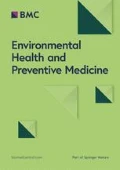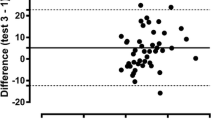Abstract
Objective
This study aimed to assess the reliability and validity of Japanese versions of the KIDSCREEN-27 (J-KIDSCREEN-27) and KIDSCREEN-10 (J-KIDSCREEN-10) questionnaires, which are shorter versions of the KIDSCREEN-52 (J-KIDSCREEN-52).
Methods
The present analyses are based on a pre-existing dataset of the J-KIDSCREEN-52 validation study, including 1564 children and adolescents aged 8–18 years and their 1326 parents. All were asked to complete the J-KIDSCREEN and Pediatric Quality of Life Inventory (PedsQL) questionnaires. Test–retest reliability was assessed with Intraclass Correlation Coefficients (ICCs) in a one-way random effects model, and internal consistency reliability was measured using Cronbach’s alpha coefficients. Agreement between child and parent scores was evaluated using ICCs in a two-way mixed effects model. To assess concurrent validity, a sub-sample of 535 parents evaluated their child’s mental health status using the Strengths and Difficulties Questionnaire (SDQ).
Results
For children, test–retest ICCs were ≥0.60 and Cronbach’s alpha ≥0.70 for every dimension of both instruments. Correlations of corresponding dimensions between the J-KIDSCREEN-27 or -10 and the PedsQL were acceptable. For parents, test–retest ICCs were ≥0.60, Cronbach’s alpha ≥0.70, and ICCs between child and parent scores ≥0.41 in every dimension of both instruments. In multivariate logistic regression models, after adjusting for confounders, lower health-related QOL in every dimension of both instruments, except Physical Well-being, was significantly associated with higher odds ratios for borderline and clinical ranges of the SDQ.
Conclusion
The child/adolescent and parent/proxy versions of the J-KIDSCREEN-27 and J-KIDSCREEN-10 demonstrated acceptable levels of reliability and validity.

Similar content being viewed by others
References
Matza LS, Swensen AR, Flood EM, Secnik K, Leidy NK. Assessment of health-related quality of life in children: a review of conceptual, methodological, and regulatory issues. Value Health. 2004;1:79–92.
Eiser C, Morse R. A review of measures of quality of life for children with chronic illness. Arch Dis Child. 2001;84(3):205–11.
Solans M, Pane S, Estrada MD, Serra-Sutton V, Berra S, Rajmil L, et al. Health-related quality of life measurement in children and adolescents: a systematic review of generic and disease-specific instruments. Value Health. 2008;11(4):742–64.
The KIDSCREEN Group Europe. The KIDSCREEN questionnaires—quality of life questionnaires for children and adolescents. Lengerich: Pabst Science Publishers; 2006.
Ravens-Sieberer U, Gosch A, Rajmil L, Erhart M, Bruil J, Duer W, et al. KIDSCREEN-52 quality-of-life measure for children and adolescents. Expert Rev Pharmacoecon Outcomes Res. 2005;5(3):353–64.
Ravens-Sieberer U, Gosch A, Rajmil L, Erhart M, Bruil J, Power M, et al. The KIDSCREEN-52 quality of life measure for children and adolescents: psychometric results from a cross-cultural survey in 13 European countries. Value Health. 2008;11(4):645–58.
Ravens-Sieberer U, Auquier P, Erhart M, Gosch A, Rajmil L, the European KIDSCREEN Group, et al. The KIDSCREEN-27 quality of life measure for children and adolescents: psychometric results from a cross-cultural survey in 13 European countries. Qual Life Res. 2007;16:1347–56.
Robitail S, Ravens-Sieberer U, Simeoni MC, Rajmil L, Bruil J, the KIDSCREEN Group, et al. Testing the structural and cross-cultural validity of the KIDSCREEN-27 quality of life questionnaire. Qual Life Res. 2007;16:1335–45.
Ravens-Sieberer U, Erhart M, Rajmil L, Herdman M, Auquier P, the European KIDSCREEN Group, et al. Reliability, construct and criterion validity of the KIDSCREEN-10 score: a short measure for children and adolescents’ well-being and health-related quality of life. Qual Life Res. 2010;19:1487–500.
Ravens-Sieberer U, Herdman M, Devine J, Otto C, Bullinger M, Rose M, et al. The European KIDSCREEN approach to measure quality of life and well-being in children: development, current application, and future advances. Qual Life Res. 2014;23(3):791–803.
Erhart M, Ottova V, Gaspar T, Jericek H, Schnohr C, Alikasifoglu M, Morgan A, Ravens-Sieberer U, HBSC Positive Health Focus Group. Measuring mental health and well-being of school-children in 15 European countries using the KIDSCREEN-10 Index. Int J Public Health. 2009;54(Suppl 2):160–6.
Klanšček HJ, Ziberna J, Korošec A, Zurc J, Albreht T. Mental health inequalities in Slovenian 15-year-old adolescents explained by personal social position and family socioeconomic status. Int J Equity Health. 2014;28(13):26.
Gouveia MJ, Frontini R, Canavarro MC, Moreira H. Quality of life and psychological functioning in pediatric obesity: the role of body image dissatisfaction between girls and boys of different ages. Qual Life Res. 2014;23(9):2629–38.
Gutter T, Brouwer OF, de Weerd AW. Subjective sleep disturbances in children with partial epilepsy and their effects on quality of life. Epilepsy Behav. 2013;28(3):481–8.
Azevedo LB, Burges Watson D, Haighton C, Adams J. The effect of dance mat exergaming systems on physical activity and health-related outcomes in secondary schools: results from a natural experiment. BMC Public Health. 2014;12(14):951.
Rajmil L, López AR, López-Aguilà S, Alonso J. Parent-child agreement on health-related quality of life (HRQOL): a longitudinal study. Health Qual Life Outcomes. 2013;20(11):101.
Jud A, Landolt MA, Tatalias A, Lach LM, Lips U. Health-related quality of life in the aftermath of child maltreatment: follow-up study of a hospital sample. Qual Life Res. 2013;22(6):1361–9.
Ravens-Sieberer U, Erhart M, Gosch A, Wille N, European KIDSCREEN Group. Mental health of children and adolescents in 12 European countries—results from the European KIDSCREEN study. Clin Psychol Psychothe. 2008;15(3):154–63.
Dey M, Mohler-Kuo M, Landolt MA. Health-related quality of life among children with mental health problems: a population-based approach. Health Qual Life Outcomes. 2012;18(10):73.
Weitkamp K, Daniels JK, Romer G, Wiegand-Grefe S. Health-related quality of life of children and adolescents with mental disorders. Health Qual Life Outcomes. 2013;11:129–35.
Sawyer MG, Whaites L, Rey JM, Hazell PL, Graetz BW, Baghurst P. Health-related quality of life of children and adolescents with mental disorders. J Am Acad Child Adolesc Psychiatry. 2002;41(5):530–7.
Stein DS, Blum NJ, Barbaresi WJ. Developmental and behavioral disorders through the life span. Pediatrics. 2011;128(2):364–73.
Shibata R, Nemoto Y, Matuzaki K, Tanaka D, Kawaguchi T, Kanda A, et al. A study of the kid-KINDL questionnaire for measuring quality of life in elementary school children in Japan. Jpn J Pediatrics. 2003;107:1521–6 (in Japanese).
Kobayashi K, Kamibeppu K. Measuring quality of life in Japanese children: development of the Japanese version of PedsQL. Pediatr Int. 2010;52(1):80–8.
Nezu S, Iwasaka H, Saeki K, Ishizuka R, Goma H, Kurumatani N, et al. Reliability and validity of the Japanese version of the KIDSCREEN-52 health-related quality of life questionnaire for children/adolescents and parents/proxies. Environ Health Prev Med. 2015;20:44–52.
Matsuishi T, Nagano M, Araki Y, Tanaka Y, Iwasaki M, Yamashita Y, et al. Scale properties of the Japanese version of the strengths and difficulties questionnaire (SDQ): a study of infant and school children in community samples. Brain Dev. 2008;30:410–5.
Varni JW, Seid M, Kurtin PS. PedsQL 4.0: reliability and validity of the Pediatric Quality of Life Inventory version 4.0 generic core scales in healthy and patient populations. Med Care. 2001;39:800–12.
Goodman R. The strengths and difficulties questionnaire: a research note. J Child Psychol Psychiatry. 1997;38:581–6.
Cohen J. Statistical power analysis for the behavioral sciences. 2nd ed. New Jersey: Lawrence Erlbaum Associates; 1988.
Bartko JJ. The intraclass correlation coefficient as a measure of reliability. Psychol Rep. 1966;19(1):3–11.
Cronbach LJ. Coefficient alpha and the internal structure of tests. Psychometrika. 1951;16:297–334.
Michel G, Bisegger C, Fuhr DC, Abel T. KIDSCREEN group. Age and gender differences in health-related quality of life of children and adolescents in Europe: a multilevel analysis. Qual Life Res. 2009;18(9):1147–57.
Hofstra MB, Van der Ende J, Verhulst FC. Continuity and change of psychopathology from childhood into adulthood: a 14-year follow-up study. J Am Acad Child Adolesc Psychiatry. 2000;39(7):850–8.
Pliszka S, AACAP Work Group on Quality Issues. Practice parameter for the assessment and treatment of children and adolescents with attention-deficit/hyperactivity disorder. J Am Acad Child Adolesc Psychiatry. 2007;46(7):894–921.
Myers SM, Johnson CP. American academy of pediatrics council on children with disabilities. Management of children with autism spectrum disorders. Pediatrics. 2007;120(5):1162–82.
Iwasaka H. Behavioral therapy for developmental disorders. Jpn J Clin Psychopharmacol. 2008;11:369–74 (in Japanese).
Acknowledgments
We thank all volunteers who participated in this study. This research was partially supported by the JSPS Grant-in-Aid for Scientific Research (B), 2012–2015, (Hidemi Iwasaka 24330264).
Author information
Authors and Affiliations
Corresponding author
Ethics declarations
Conflict of interest
The authors declare that they have no conflict of interest.
Ethical approval
All procedures performed in studies involving human participants were in accordance with the ethical standards of the institutional committee and with the 1964 Helsinki declaration and its later amendments or comparable ethical standards.
Rights and permissions
About this article
Cite this article
Nezu, S., Iwasaka, H., Saeki, K. et al. Reliability and validity of Japanese versions of KIDSCREEN-27 and KIDSCREEN-10 questionnaires. Environ Health Prev Med 21, 154–163 (2016). https://doi.org/10.1007/s12199-016-0510-x
Received:
Accepted:
Published:
Issue Date:
DOI: https://doi.org/10.1007/s12199-016-0510-x



